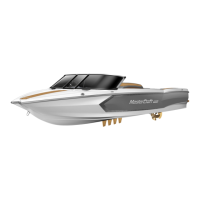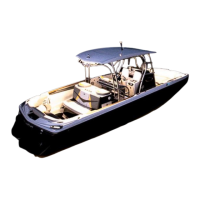NAUTICAL TERMINOLOGY
3-1
Nautical Terminology
Usually, boating rookies are immediately identifiable
because they don’t know the lingo. However, it’s easy to
pick up, and once you have you join the exclusive club
that is the boating world.
To help you get a jump on understanding nautical
terminology and communicating better with everyone
you meet on the water, here are some of the more
common terms:
ABROAD . . . On or within the boat.
ABREAST . . . Side by side; by the side of another boat
or object.
ADRIFT . . . Loose; not on moorings or towline.
AFT . . . Toward the back (or stern) of the boat.
AGROUND . . . Touching the bottom of the lake or river
with the hull of the boat.
AHEAD . . . In a forward direction.
AIDS TO NAVIGATION . . . Artificial objects to supple-
ment natural landmarks indicating safe or unsafe waters.
ALEE . . . Away from the direction of the wind. Opposite
of windward.
AMIDSHIPS . . . In or toward the center of the boat.
ANCHORAGE . . . A place suitable for anchoring in
relation to the wind, seas and bottom.
ASTERN . . . The position of the anchor as it is raised
clear of the bottom.
BATTEN DOWN . . . Secure hatches and loose objects
both within the hull and on deck.
BEAM . . . The greatest width of the boat.
BEARING . . . The direction of
an object expressed either as a
true bearing as shown on the
chart, or as a bearing relative to
the boat’s heading.
BELOW . . . Beneath the deck.
BIGHT . . . The part of the rope
or line between the end and the
standing part on which a knot is
formed.
BOAT . . . An indefinite term but
generally refers to a waterborne
vehicle smaller than a ship, which
is usually thought of as being used
for ocean travel or transport of
goods.
BOAT HOOK . . . A short shaft
with a fitting at one end shaped
to facilitate use in putting a line
over a piling, recovering an ob-
ject dropped overboard or in
pushing off.
BOW . . . The forward part of the boat, usually for-
ward of the driver’s compartment.
BOW LINE . . . A docking line leading from the bow.
BUOY . . . An anchored float used for marking a
position on the water, a hazard or a shoal, and
for mooring.
CAPSIZE . . . To turn over.
CAST OFF . . . To remove mooring lines and move
away from the dock.
CHART . . . A map for use by navigators.
CHINE . . . The intersection of the bottom and sides
of a flat or v-bottomed boat.
CHOCK . . . A fitting through which anchor or moor-
ing lines are led. Usually U-shaped to reduce chafe.
CLEAT . . . A fitting to which lines are made fast. The
classic cleat to which lines are secured is roughly
anvil-shaped.
CLOVE HITCH . . . A knot for temporarily fastening
a line to a spar or piling.
COIL . . . To lay a line down in circular turns to avoid
snags or unwanted knots.
COURSE . . . The direction in which a boat is steered.
CURRENT . . . The horizontal movement of water.
DEAD AHEAD . . . Directly ahead.
DEAD STERN . . . Directly aft or behind.
DECK . . . A permanent covering over a hull.
DISPLACEMENT . . . The weight of water displaced
by a floating vessel.
DOCK . . . A protected water area in which vessels
are moored. The term is often used to denote a pier
or a wharf.

